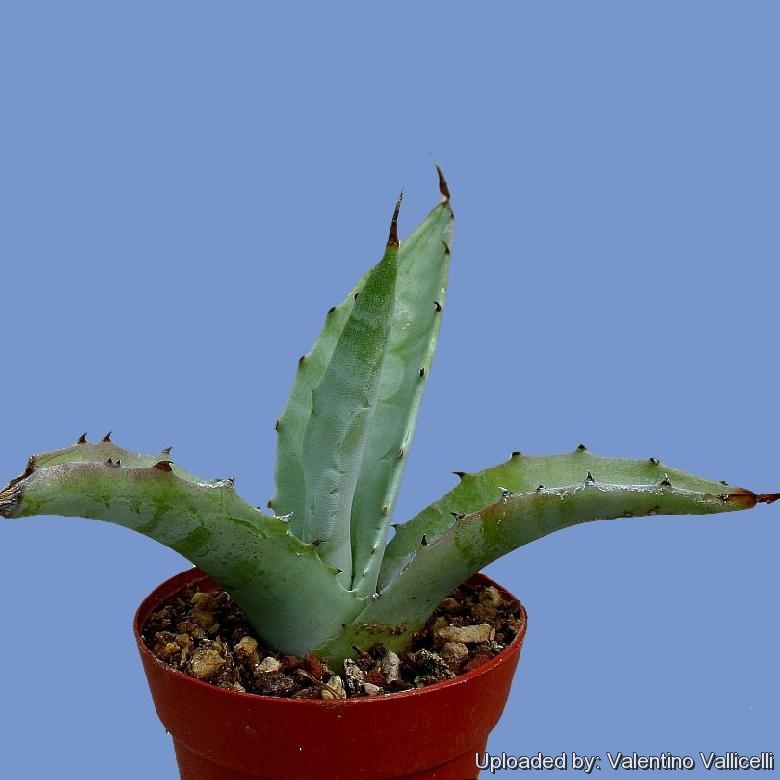
Agave cerulata ssp. cerulata
A nice glaucous blue species, growing in large clumps. The narrow leaves bear widely-spaced small marginal teeth.
Origin and Habitat: Central portion of the Lower California peninsula.
Habitat: Rocky, rolling plains, and rocky slopes of hills on heavy-textured soil among volcanic or granitic rocks, from near the sea, where fog mitigate the arid climate, to inland where the conditions are warmer and dryer up to 900(-1300) above sea level. It is often found growing with Pachycormus discolor , Pachycereus pringleiSN|8572]]SN|8572]], Fouquieria columnarisSN|30206]]SN|30206]], and Yucca valida. Precipitation bi-seasonal mostly in winter and summer.
Type locality: The type specimen was collected at about 240 meters altitude at Calmalli.
Synonyms:
See all synonyms of Agave cerulata
Description: Agave cerulataSN|361]]SN|361]] is a small to medium abundantly surculose agave.
Rosettes: Small 20- 50(-70) cm hight,.
Leaves. Few, 20-40(60) cm long and 4-8 cm wide, light grey, yellowish, or pale green, (rarely light glaucous-grey) some-times cross-zoned, linear-lanceolate, to triangular-lanceolate, 6-12 times as long as broad, and broadest at or slightly below the middle and acuminate. Margins entire to slightly undulate, irregularly shaped, with small (1-5 mm) weakly attached teeth irregularly spaced sometimes lacking through much of the lamina. Narrow rings of brown tissue around the bases of the marginal teeth are characteristic of Agave cerulataSN|361]]SN|361]]. Terminal spine acicular. 3-6 cm long, light to dark grey, decurrent only to the uppermost teeth or less.
Flowers: Paniculate 2-4 m tall with 5-20 small, lateral umbels.
Flowers: 45 - 60 mm long yellow. Ovary fusiform. 22 - 32 mm long; Tepals in bud white waxy glaucous, opening pale yellow, tube broadly funnel-shaped or discoid, with thick nectar glandes and bulges opposite the filament insertions, 3 - 5 mm long, lobes 16-22 mm long.
Blooming season: March-April.
Subspecies, varieties, forms and cultivars of plants belonging to the Agave cerulata group
 Agave cerulata Trel.: (subsp. cerulata) Leaves yellowish 25-40 cm long and 4-8 cm wide. 6-12 times as long as broad. Distribution: Central Lower California
Agave cerulata Trel.: (subsp. cerulata) Leaves yellowish 25-40 cm long and 4-8 cm wide. 6-12 times as long as broad. Distribution: Central Lower California- Agave cerulata subs. dentiens (Trel.) Gentry: has long-acuminate, grayish leaves and broad panicles Distribution: Isla San Esteban (and perhaps also Isla Angel de la Guarda and the adjacent peninsula)
 Agave cerulata subs. nelsonii (Trel.) Gentry: has somewhat undulate to nearly entire leaves that are 25-40 cm long, 3-6 times as long as broad, and broadest near or below the middle. Distribution: North-western end of the range.
Agave cerulata subs. nelsonii (Trel.) Gentry: has somewhat undulate to nearly entire leaves that are 25-40 cm long, 3-6 times as long as broad, and broadest near or below the middle. Distribution: North-western end of the range.- Agave cerulata subs. subcerulata Gentry: has crenate leaves that are 15-30 cm long, 3-6 times as long as broad, and generally broadest above the middle. Distribution south-eastern part of the of the range.
Bibliography: Major references and further lectures
1) Howard Scott Gentry "Agaves of Continental North America" University of Arizona Press, 01/Feb./2004
2) Urs Eggli "Illustrated Handbook of Suculent Plants: Monocotyledons" Springer, 2001
3) Raymond M. Turner, Janice Emily Bowers, Tony L. Burgess “Sonoran Desert Plants: An Ecological Atlas” University of Arizona Press, 2005
Cultivation and Propagation: They are usually cultivated outdoors in rock gardens, in cactus and succulent gardens, in Mediterranean-style landscapes, in borders, or as a specimen.
Growth rate: It is a relatively rapidly growing given the best conditions.
Exposure: They do well in full sun or a lightly shaded area with afternoon shade.
Soil: They do best in very well-drained, sandy or gravely soil. As an ornamental it is also grown in containers where it stays much smaller than its outdoor brethren. In pots they need a very porous mix soil (e.g. 2 parts peat moss to 1 part loam to 1 part of pumice).
Repotting: Use pot with good drainage.
Fertilization: They grows quickly if kept well nourished with a slow release fertilizer specifically formulated for cactus and succulents applied once or twice a year (poor in nitrogen), including all micro nutrients and trace elements.
Hardiness: Keep it in a cool, frost-free area in winter and put it out on the balcony or patio in summer. It grows fairly fast in summer if provided with copious water but allows to dry thoroughly before watering again. During the winter months, one should only water enough to keep the leaves from shriveling.
Scenography: These striking plants are wonderful when used for accent or simply to provide some all year round foliage and often used in a pot as a patio plant, can be moved around to change the scenery or position to give more shelter.
Traditional uses: Cochimí Indians of the central peninsula ate the stems, which contain a lower level of sapogenins than the leaves. The Seri made a beverage from the juice of macerated leaves.
Warning: It can get large, and it is armed with needle-sharp spines.
Propagation: Seeds or suckers which often are found growing around the base of the plant, Remove the basal suckers (if available) in spring or summer and let the cuttings dry for a few days before inserting in compost.











